fuse LINCOLN MKC 2015 Owners Manual
[x] Cancel search | Manufacturer: LINCOLN, Model Year: 2015, Model line: MKC, Model: LINCOLN MKC 2015Pages: 490, PDF Size: 4.74 MB
Page 7 of 490
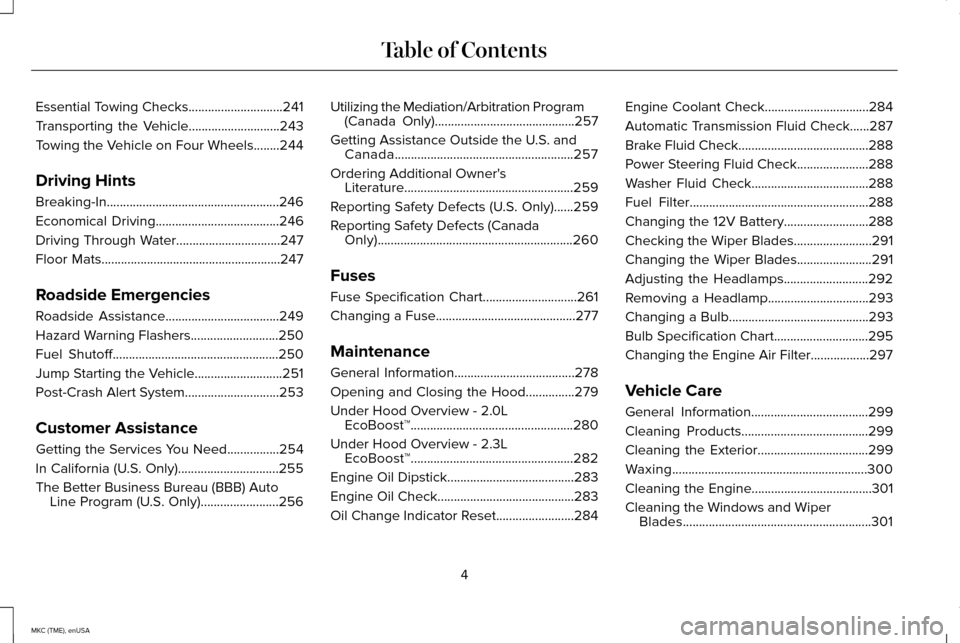
Essential Towing Checks.............................241
Transporting the Vehicle............................243
Towing the Vehicle on Four Wheels........244
Driving Hints
Breaking-In.....................................................246
Economical Driving......................................246
Driving Through Water................................247
Floor Mats.......................................................247
Roadside Emergencies
Roadside Assistance
...................................249
Hazard Warning Flashers
...........................250
Fuel Shutoff
...................................................250
Jump Starting the Vehicle...........................251
Post-Crash Alert System.............................253
Customer Assistance
Getting the Services You Need
................254
In California (U.S. Only)...............................255
The Better Business Bureau (BBB) Auto Line Program (U.S. Only)........................256 Utilizing the Mediation/Arbitration Program
(Canada Only)
...........................................257
Getting Assistance Outside the U.S. and Canada.......................................................257
Ordering Additional Owner's Literature....................................................259
Reporting Safety Defects (U.S. Only)......259
Reporting Safety Defects (Canada Only)............................................................260
Fuses
Fuse Specification Chart
.............................261
Changing a Fuse...........................................277
Maintenance
General Information
.....................................278
Opening and Closing the Hood
...............279
Under Hood Overview -
2.0L
EcoBoost™..................................................280
Under Hood Overview -
2.3L
EcoBoost™..................................................282
Engine Oil Dipstick
.......................................283
Engine Oil Check
..........................................283
Oil Change Indicator Reset........................284 Engine Coolant Check................................284
Automatic Transmission Fluid Check......287
Brake Fluid Check
........................................288
Power Steering Fluid Check ......................
288
Washer Fluid Check....................................288
Fuel Filter
.......................................................288
Changing the 12V Battery..........................288
Checking the Wiper Blades
........................291
Changing the Wiper Blades.......................291
Adjusting the Headlamps..........................292
Removing a Headlamp
...............................293
Changing a Bulb
...........................................293
Bulb Specification Chart
.............................295
Changing the Engine Air Filter..................297
Vehicle Care
General Information....................................299
Cleaning Products
.......................................299
Cleaning the Exterior..................................299
Waxing
............................................................300
Cleaning the Engine.....................................301
Cleaning the Windows and Wiper Blades..........................................................301
4
MKC (TME), enUSA Table of Contents
Page 11 of 490
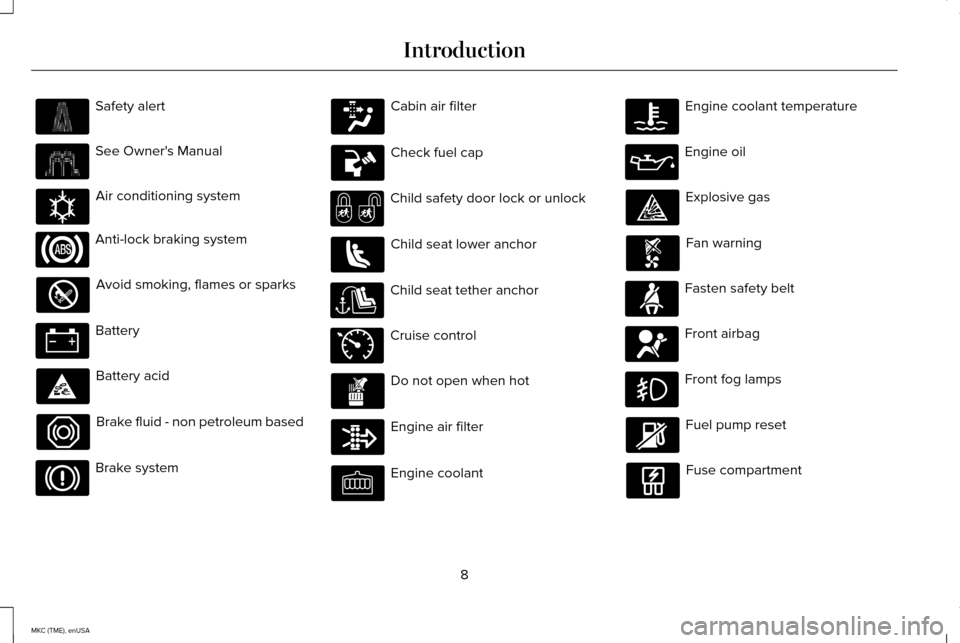
Safety alert
See Owner's Manual
Air conditioning system
Anti-lock braking system
Avoid smoking, flames or sparks
Battery
Battery acid
Brake fluid - non petroleum based
Brake system Cabin air filter
Check fuel cap
Child safety door lock or unlock
Child seat lower anchor
Child seat tether anchor
Cruise control
Do not open when hot
Engine air filter
Engine coolant Engine coolant temperature
Engine oil
Explosive gas
Fan warning
Fasten safety belt
Front airbag
Front fog lamps
Fuel pump reset
Fuse compartment
8
MKC (TME), enUSA Introduction E162384 E71340
Page 50 of 490
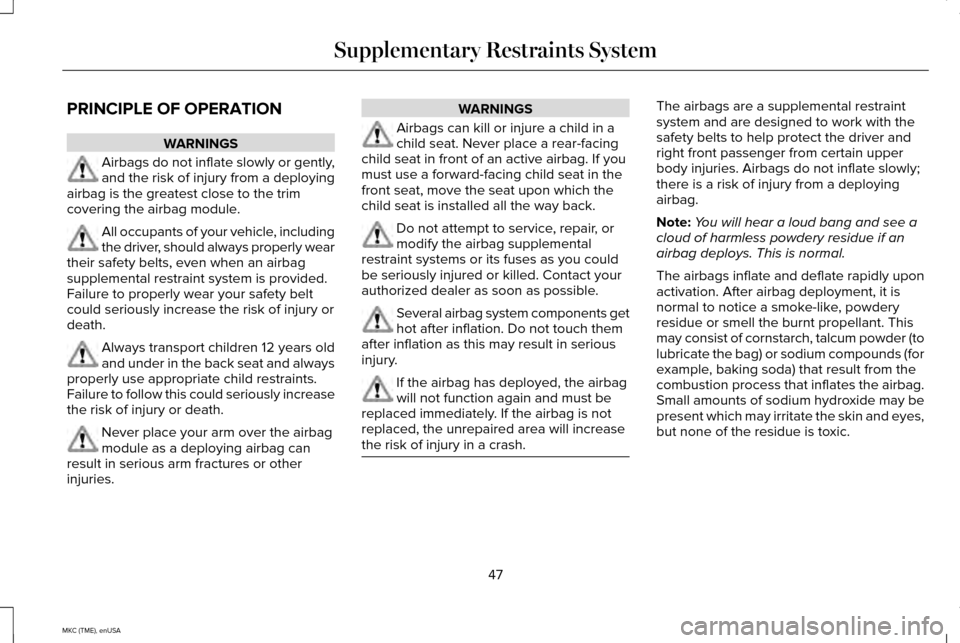
PRINCIPLE OF OPERATION
WARNINGS
Airbags do not inflate slowly or gently,
and the risk of injury from a deploying
airbag is the greatest close to the trim
covering the airbag module. All occupants of your vehicle, including
the driver, should always properly wear
their safety belts, even when an airbag
supplemental restraint system is provided.
Failure to properly wear your safety belt
could seriously increase the risk of injury or
death. Always transport children 12 years old
and under in the back seat and always
properly use appropriate child restraints.
Failure to follow this could seriously increase
the risk of injury or death. Never place your arm over the airbag
module as a deploying airbag can
result in serious arm fractures or other
injuries. WARNINGS
Airbags can kill or injure a child in a
child seat. Never place a rear-facing
child seat in front of an active airbag. If you
must use a forward-facing child seat in the
front seat, move the seat upon which the
child seat is installed all the way back. Do not attempt to service, repair, or
modify the airbag supplemental
restraint systems or its fuses as you could
be seriously injured or killed. Contact your
authorized dealer as soon as possible. Several airbag system components get
hot after inflation. Do not touch them
after inflation as this may result in serious
injury. If the airbag has deployed, the airbag
will not function again and must be
replaced immediately. If the airbag is not
replaced, the unrepaired area will increase
the risk of injury in a crash. The airbags are a supplemental restraint
system and are designed to work with the
safety belts to help protect the driver and
right front passenger from certain upper
body injuries. Airbags do not inflate slowly;
there is a risk of injury from a deploying
airbag.
Note:
You will hear a loud bang and see a
cloud of harmless powdery residue if an
airbag deploys. This is normal.
The airbags inflate and deflate rapidly upon
activation. After airbag deployment, it is
normal to notice a smoke-like, powdery
residue or smell the burnt propellant. This
may consist of cornstarch, talcum powder (to
lubricate the bag) or sodium compounds (for
example, baking soda) that result from the
combustion process that inflates the airbag.
Small amounts of sodium hydroxide may be
present which may irritate the skin and eyes,
but none of the residue is toxic.
47
MKC (TME), enUSA Supplementary Restraints System
Page 55 of 490

on the floor. Sitting improperly can increase
the chance of injury in a crash event. For
example, if an occupant slouches, lies down,
turns sideways, sits forward, leans forward
or sideways, or puts one or both feet up, the
chance of injury during a crash is greatly
increased.
The conditions listed above may cause the
weight of a properly seated occupant to be
incorrectly interpreted by the front passenger
sensing system. The person in the front
passenger seat may appear heavier or lighter
due to the conditions described in the list
above.
Make sure the front passenger
sensing system is operating
properly. See Crash Sensors and
Airbag Indicator (page 55).
Do not attempt to repair or service the
system. Take your vehicle immediately to an
authorized dealer.
If it is necessary to modify an advanced front
airbag system to accommodate a person
with disabilities, contact the Ford Customer
Relationship Center.
See Getting the
Services You Need (page 254). SIDE AIRBAGS WARNINGS
Do not place objects or mount
equipment on or near the airbag cover,
on the side of the seatbacks (of the front
seats), or in front seat areas that may come
into contact with a deploying airbag. Failure
to follow these instructions may increase the
risk of personal injury in the event of a crash. Do not use accessory seat covers. The
use of accessory seat covers may
prevent the deployment of the side airbags
and increase the risk of injury in an accident. Do not lean your head on the door. The
side airbag could injure you as it
deploys from the side of the seatback. Do not attempt to service, repair, or
modify the airbag, its fuses or the seat
cover on a seat containing an airbag as you
could be seriously injured or killed. Contact
your authorized dealer as soon as possible. WARNINGS
If the side airbag has deployed, the
airbag will not function again. The side
airbag system (including the seat) must be
inspected and serviced by an authorized
dealer. If the airbag is not replaced, the
unrepaired area will increase the risk of injury
in a crash. The side airbags are located on the outboard
side of the seatbacks of the front seats. In
certain sideways crashes, the airbag on the
side affected by the crash will be inflated.
The airbag was designed to inflate between
the door panel and occupant to further
enhance the protection provided occupants
in side impact crashes.
52
MKC (TME), enUSA Supplementary Restraints System
Page 56 of 490
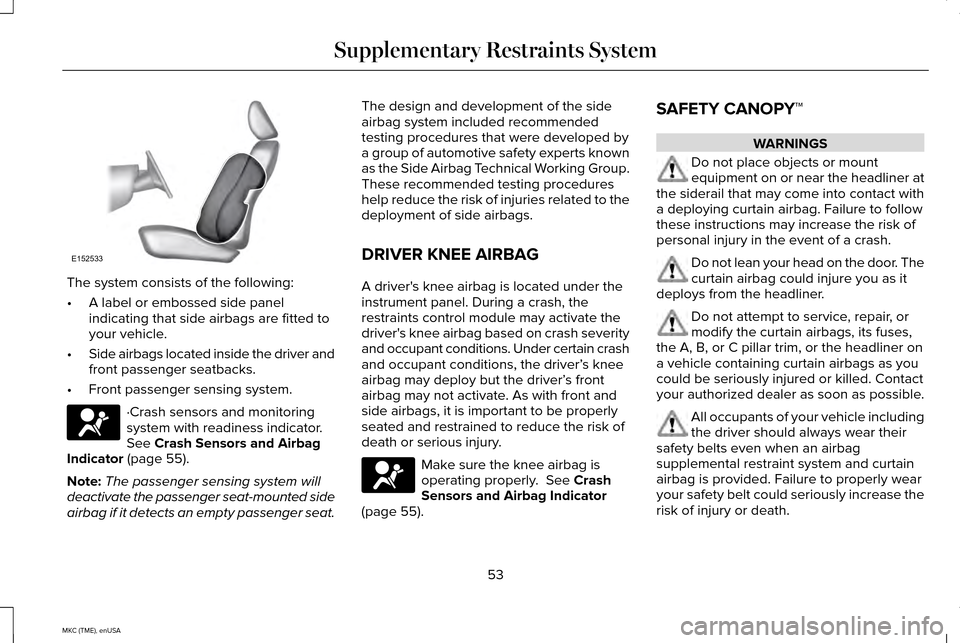
The system consists of the following:
•
A label or embossed side panel
indicating that side airbags are fitted to
your vehicle.
• Side airbags located inside the driver and
front passenger seatbacks.
• Front passenger sensing system. ·Crash sensors and monitoring
system with readiness indicator.
See Crash Sensors and Airbag
Indicator (page 55).
Note: The passenger sensing system will
deactivate the passenger seat-mounted side
airbag if it detects an empty passenger seat. The design and development of the side
airbag system included recommended
testing procedures that were developed by
a group of automotive safety experts known
as the Side Airbag Technical Working Group.
These recommended testing procedures
help reduce the risk of injuries related to the
deployment of side airbags.
DRIVER KNEE AIRBAG
A driver's knee airbag is located under the
instrument panel. During a crash, the
restraints control module may activate the
driver's knee airbag based on crash severity
and occupant conditions. Under certain crash
and occupant conditions, the driver’
s knee
airbag may deploy but the driver’ s front
airbag may not activate. As with front and
side airbags, it is important to be properly
seated and restrained to reduce the risk of
death or serious injury. Make sure the knee airbag is
operating properly.
See Crash
Sensors and Airbag Indicator
(page
55). SAFETY CANOPY™ WARNINGS
Do not place objects or mount
equipment on or near the headliner at
the siderail that may come into contact with
a deploying curtain airbag. Failure to follow
these instructions may increase the risk of
personal injury in the event of a crash. Do not lean your head on the door. The
curtain airbag could injure you as it
deploys from the headliner. Do not attempt to service, repair, or
modify the curtain airbags, its fuses,
the A, B, or C pillar trim, or the headliner on
a vehicle containing curtain airbags as you
could be seriously injured or killed. Contact
your authorized dealer as soon as possible. All occupants of your vehicle including
the driver should always wear their
safety belts even when an airbag
supplemental restraint system and curtain
airbag is provided. Failure to properly wear
your safety belt could seriously increase the
risk of injury or death.
53
MKC (TME), enUSA Supplementary Restraints SystemE152533
Page 158 of 490
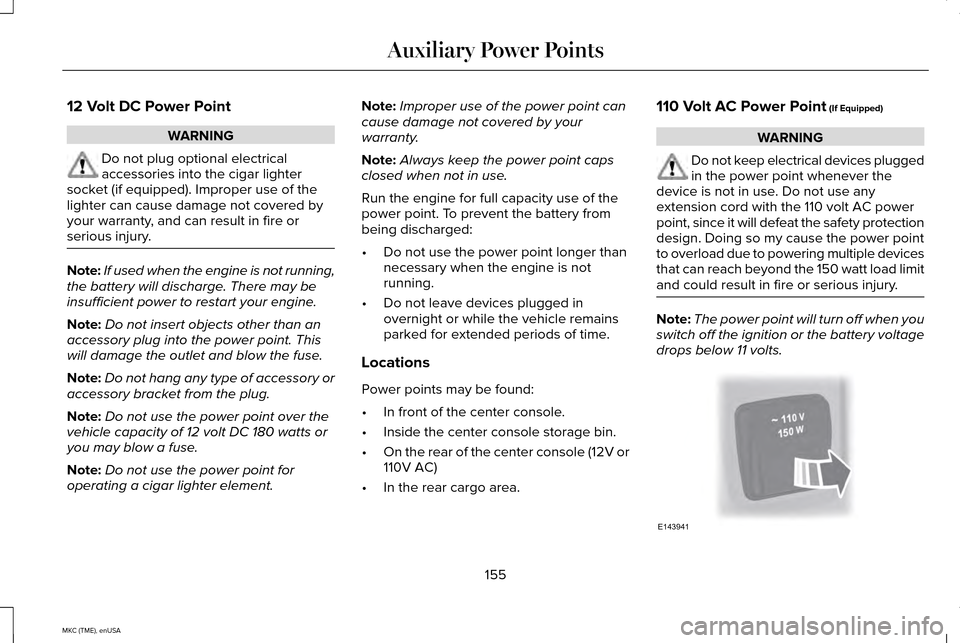
12 Volt DC Power Point
WARNING
Do not plug optional electrical
accessories into the cigar lighter
socket (if equipped). Improper use of the
lighter can cause damage not covered by
your warranty, and can result in fire or
serious injury. Note:
If used when the engine is not running,
the battery will discharge. There may be
insufficient power to restart your engine.
Note: Do not insert objects other than an
accessory plug into the power point. This
will damage the outlet and blow the fuse.
Note: Do not hang any type of accessory or
accessory bracket from the plug.
Note: Do not use the power point over the
vehicle capacity of 12 volt DC 180 watts or
you may blow a fuse.
Note: Do not use the power point for
operating a cigar lighter element. Note:
Improper use of the power point can
cause damage not covered by your
warranty.
Note: Always keep the power point caps
closed when not in use.
Run the engine for full capacity use of the
power point. To prevent the battery from
being discharged:
• Do not use the power point longer than
necessary when the engine is not
running.
• Do not leave devices plugged in
overnight or while the vehicle remains
parked for extended periods of time.
Locations
Power points may be found:
• In front of the center console.
• Inside the center console storage bin.
• On the rear of the center console (12V or
110V AC)
• In the rear cargo area. 110 Volt AC Power Point (If Equipped) WARNING
Do not keep electrical devices plugged
in the power point whenever the
device is not in use. Do not use any
extension cord with the 110 volt AC power
point, since it will defeat the safety protection
design. Doing so my cause the power point
to overload due to powering multiple devices
that can reach beyond the 150 watt load limit
and could result in fire or serious injury. Note:
The power point will turn off when you
switch off the ignition or the battery voltage
drops below 11 volts. 155
MKC (TME), enUSA Auxiliary Power PointsE143941
Page 242 of 490
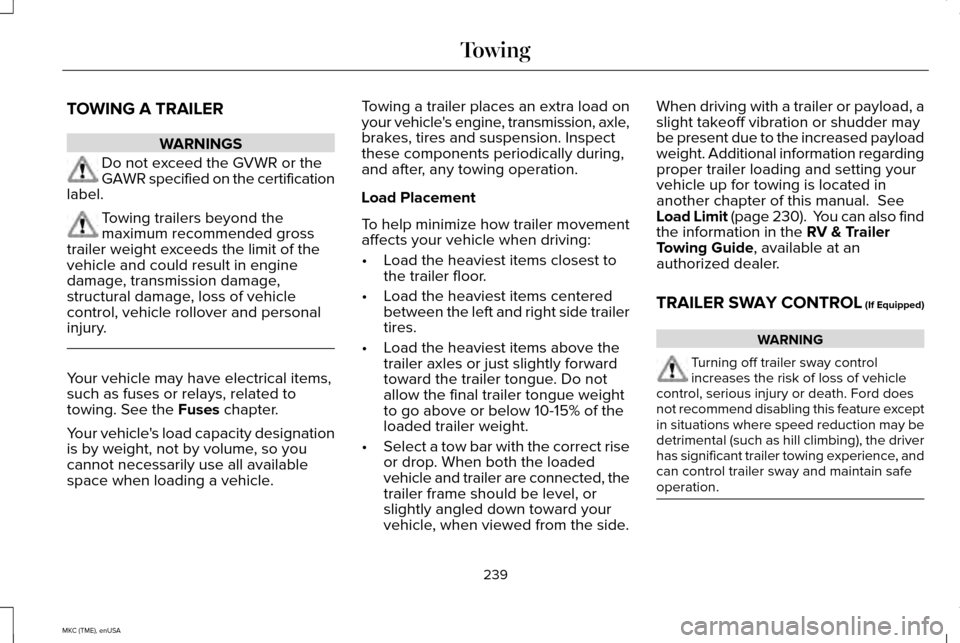
TOWING A TRAILER
WARNINGS
Do not exceed the GVWR or the
GAWR specified on the certification
label. Towing trailers beyond the
maximum recommended gross
trailer weight exceeds the limit of the
vehicle and could result in engine
damage, transmission damage,
structural damage, loss of vehicle
control, vehicle rollover and personal
injury. Your vehicle may have electrical items,
such as fuses or relays, related to
towing. See the Fuses chapter.
Your vehicle's load capacity designation
is by weight, not by volume, so you
cannot necessarily use all available
space when loading a vehicle. Towing a trailer places an extra load on
your vehicle's engine, transmission, axle,
brakes, tires and suspension. Inspect
these components periodically during,
and after, any towing operation.
Load Placement
To help minimize how trailer movement
affects your vehicle when driving:
•
Load the heaviest items closest to
the trailer floor.
• Load the heaviest items centered
between the left and right side trailer
tires.
• Load the heaviest items above the
trailer axles or just slightly forward
toward the trailer tongue. Do not
allow the final trailer tongue weight
to go above or below 10-15% of the
loaded trailer weight.
• Select a tow bar with the correct rise
or drop. When both the loaded
vehicle and trailer are connected, the
trailer frame should be level, or
slightly angled down toward your
vehicle, when viewed from the side. When driving with a trailer or payload, a
slight takeoff vibration or shudder may
be present due to the increased payload
weight. Additional information regarding
proper trailer loading and setting your
vehicle up for towing is located in
another chapter of this manual.
See
Load Limit (page 230). You can also find
the information in the
RV & Trailer
Towing Guide, available at an
authorized dealer.
TRAILER SWAY CONTROL (If Equipped) WARNING
Turning off trailer sway control
increases the risk of loss of vehicle
control, serious injury or death. Ford does
not recommend disabling this feature except
in situations where speed reduction may be
detrimental (such as hill climbing), the driver
has significant trailer towing experience, and
can control trailer sway and maintain safe
operation. 239
MKC (TME), enUSA Towing
Page 264 of 490

FUSE SPECIFICATION CHART
Pre-Fuse Box
The pre-fuse box is in the engine
compartment attached to the positive battery
post. This box contains several high current
fuses. If you need to replace one of these
high current fuses, see an authorized dealer.
Power Distribution Box WARNINGS
Always disconnect the battery before
servicing high current fuses.
To reduce risk of electrical shock,
always replace the cover to the power
distribution box before reconnecting the
battery or refilling fluid reservoirs. The power distribution box is in the engine
compartment. It has high-current fuses that
protect your vehicle's main electrical systems
from overloads.
You will need to reset some features if you
disconnect and reconnect the battery. See
Changing the 12V Battery (page 288).
Lift the release lever at the rear of the cover
to remove it.
261
MKC (TME), enUSA Fuses
Page 265 of 490
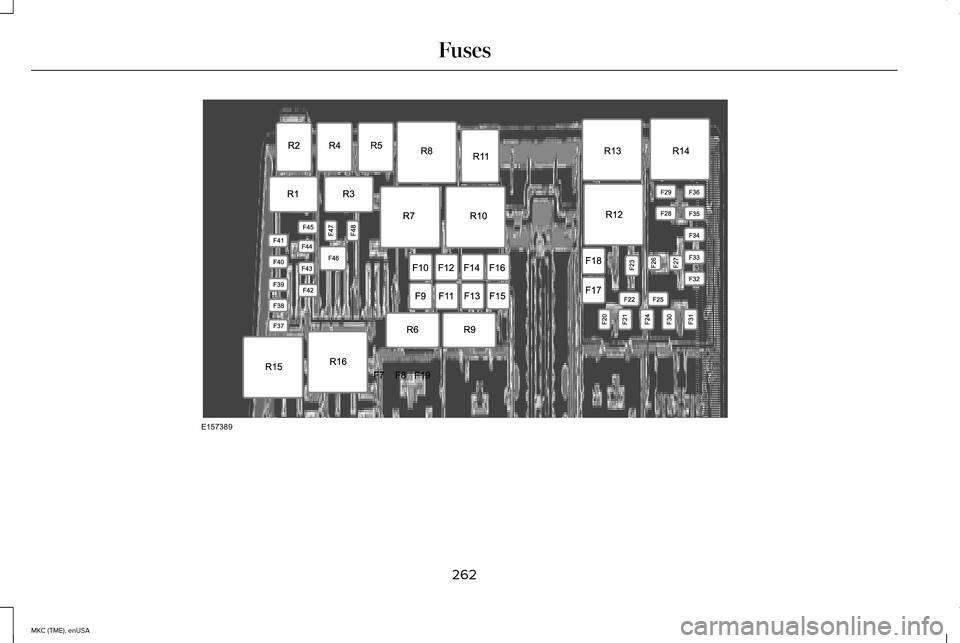
262
MKC (TME), enUSA FusesE157389
Page 266 of 490
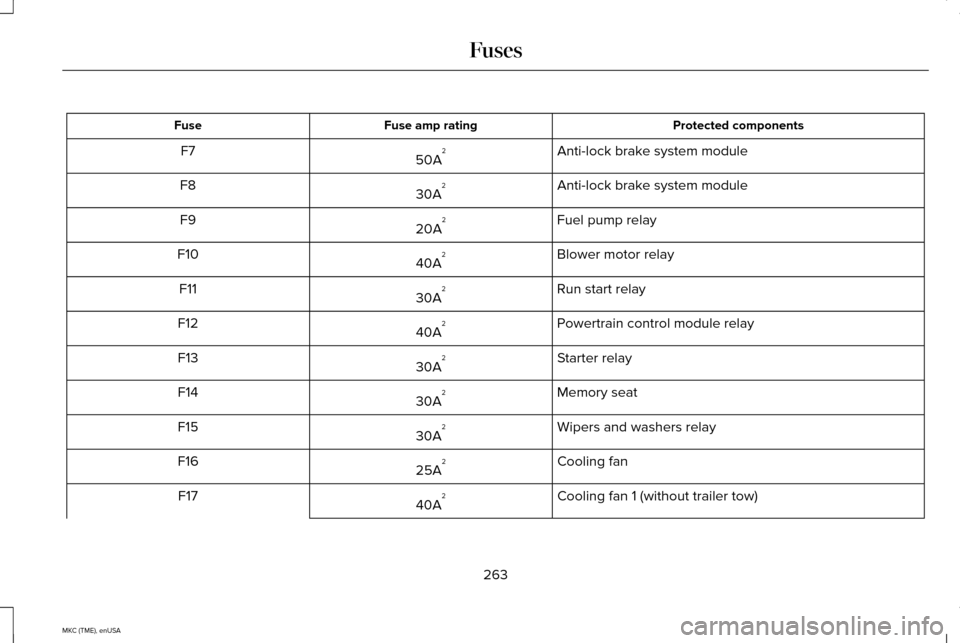
Protected components
Fuse amp rating
Fuse
Anti-lock brake system module
50A 2
F7
Anti-lock brake system module
30A 2
F8
Fuel pump relay
20A 2
F9
Blower motor relay
40A 2
F10
Run start relay
30A 2
F11
Powertrain control module relay
40A 2
F12
Starter relay
30A 2
F13
Memory seat
30A 2
F14
Wipers and washers relay
30A 2
F15
Cooling fan
25A 2
F16
Cooling fan 1 (without trailer tow)
40A 2
F17
263
MKC (TME), enUSA Fuses